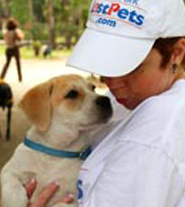Learn How To Prevent Dog Bites
Thank you to Dr. Yin's Animal Behavior and Medicine Blog
Preventing Dog Bites by Learning to Greet Dogs Properly
Posted On: Tuesday, May 17th, 2012
By Dr Sophia Yin
The consensus among animal behavior professionals is that the major cause of dog bites to humans
is related to failure of owners and dog bite victimsto recognize when dogs are fearful and know how to approach
and greet dogs appropriately. But what exactly is the correct approach and why do so many people fail to do it?
One issue is that we humans have an instant gut reaction to the cuteness of some dogs. It’s the same reaction we
had as a child when we saw a cute teddy bear or other stuffed animal. As a result we treat pets as if they are cuddly
toys. While many dogs are friendly, cute, and love interacting with humans, they are definitely not toys. In fact, when
you think about it, dogs are a bit like humans in that the same types of inappropriate greetings that would cause a human
to be afraid or irritated would cause a dog to become fearful and even aggressive too. Here are some examples:
Posted On: Tuesday, May 17th, 2012
By Dr Sophia Yin
The consensus among animal behavior professionals is that the major cause of dog bites to humans
is related to failure of owners and dog bite victimsto recognize when dogs are fearful and know how to approach
and greet dogs appropriately. But what exactly is the correct approach and why do so many people fail to do it?
One issue is that we humans have an instant gut reaction to the cuteness of some dogs. It’s the same reaction we
had as a child when we saw a cute teddy bear or other stuffed animal. As a result we treat pets as if they are cuddly
toys. While many dogs are friendly, cute, and love interacting with humans, they are definitely not toys. In fact, when
you think about it, dogs are a bit like humans in that the same types of inappropriate greetings that would cause a human
to be afraid or irritated would cause a dog to become fearful and even aggressive too. Here are some examples:
 |
| Appropriate and inappropriate approaches: People frequently see a cute pooch and want to rush up to pet him. Just as you might feel scared if a stranger or even an acquaintance ran right up to you, a dog may feel uncomfortable too. It’s best to approach slowly—at a leisurely walk while watching the dog for body language signs of fear (Download this poster showing fearful body language in dogs) |
 |
Appropriate and inappropriate approaches: It’s mostly kids who rush up uncontrollably to pet a dog, but even adults encroach threateningly. For instance, suddenly reaching out from nowhere without first asking parents or the owner can lead to bad results. Even children are nervous of strangers approaching, and rightly so. We shouldn’t expect our dogs to be more comfortable with stranger danger than our kids. That’s why it’s important to always ask owners if it’s OK to greet their pets. It’s up to the owner to know their pet well enough they can inform others if it’s safe to pet their dog and if the dog will enjoy the interaction. |
 |
Appropriate and inappropriate approaches: Starting in childhood, we were all told to avoid staring. It’s rude, and even creepy. So even if a dog’s owner says it’s OK to greet Rover, avoid approaching head-on and staring. Instead, approach offset or sideways and look using your peripheral vision. |
 |
Appropriate and inappropriate greetings: Have you ever seen a toddler or young child visiting Disneyland or some other theme park to see their favorite beloved cartoon character? But when they see Mickey Mouse or Yogi Bear he’s gigantic in size and looming over them and they get scared. The same thing happens to dogs. They may seem friendly and happy as you approach, but if you loom over them, especially if you’re facing them head on, you can cause them to have a meltdown. That’s why it’s better to stand facing slightly sideways and remain outside their personal space or bubble. Note that the size of the bubble varies from dog to dog. Then let them approach at their own rate if they feel like it. If they don’t feel like approaching, then just admire them from a distance. For little dogs you can squat down to their level. But be careful to do so from far away and face sideways so that when you are shorter your face isn’t right in their face. |
 |
Appropriate and inappropriate greetings: Although you’ve probably heard that you should greet dogs by letting them sniff your hand, reaching out to their face is actually pretty rude, especially if you’re facing them or staring. Imagine if someone was standing near you and they reached a hand out towards you. It’s best to let the dog approach at his own rate and avoid putting pressure on him by reaching out. |
 |
| Appropriate and inappropriate greetings: Some kids have phobias about clowns or certain types of people. Similarly some dogs are afraid of some types of people or people wearing or carrying certain objects or in various environments. Even if you’ve followed all of the appropriate greeting rules so far, some pets may still feel uncomfortable. So if you see signs of fear, discomfort or tension (link to the dog body language/ dog bite prevention-the one from Friday’s blog), even if the dog comes up to sniff you, still avoid petting him. Instead just admire the pet from nearby. |
 |
Appropriate and inappropriate interactions: Lastly, remember that some interactions are just not appropriate or aren’t as fun for the animal (or for children) as you think. For instance, most kids don’t like being pinched on the cheek even if they will put up with it. Similarly most dogs dislike being hugged even by family members even if they allow it. Imagine how a dog who dislikes hugging might react if they are hugged by someone with whom they’re only mildly familiar. When interacting with a dog, especially an unfamiliar one, avoid hugging, patting or petting in an overly familiar way. Instead pet in a calm, gentle, relaxed manner. |
While many humans routinely greet dogs inappropriately and many dogs put up with this socially inappropriate behavior,
if you stop and think about it, correct greetings are common sense. We should be respectful of dogs instead of assuming
they should be friendly and polite even when we humans are not.
For more great articles visit Dr Yins Blog

Cofounder and Sponsor

Shelley Heistand
Premier Sotheby’s International Realty
407-718-9222
Cofounder Executive Director

Judy Charuhas
Contact Judy here

